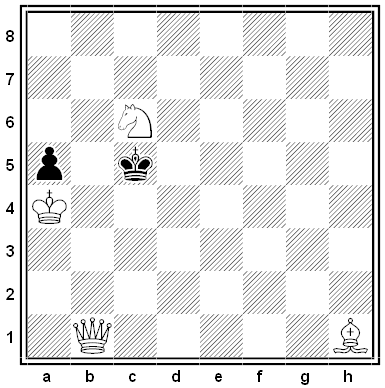This solution is by Howard Haber, who writes, “The key observation is that if two of the three integers are equal, then the person who sees the equal integers knows that his number is twice the same integer.”
Disregard the actual values for the moment and focus on their ratio instead. For A, B, C respectively, this ratio must be 5, 2, 3. To see why, consider the first round. A, who sees the numbers 2, 3, concludes that he himself must be wearing either 1 (1 + 2 = 3) or 5 (2 + 3 = 5). A can’t get any further than this in the first round and watches the play continue, adopting for the moment the hypothesis that A, B, C are 1, 2, 3. He’s not surprised when B passes his turn, then, because that’s consistent with his idea: B would have seen A wearing 1 and C wearing 3 and been unable to decide whether he himself were wearing 2 (1 + 2 = 3) or 4 (1 + 3 = 4). So he’d pass. So far, so good. Now play passes to C. If A, B, C were 1, 2, 3, then C would see A wearing 1 and B wearing 2. That would tell C that he himself must be wearing 3 (1 + 2 = 3) or 1 (1 + 1 = 2). But unlike the first two players, C would have a way to eliminate one of his candidates: He would know that he himself could not be wearing 1, because if he were, then B would have seen the numbers 1 and 1 on his turn, and thus would have realized that his own (B’s) number must have been 2 (according to the key observation above). With that insight B would have had enough information to win the game on his turn — he could have declared that A, B, C were 1, 2, 1. But B passed his turn, revealing to C that B was unable to reach that conclusion. And seeing that, C could then have concluded that the numbers could not have been 1, 2, 1 and so must have been 1, 2, 3.
But C too passes his turn. That tells A (finally!) that his starting hypothesis was wrong: A, B, C can’t be 1, 2, 3. That leaves only the second possibility he’d identified, where A, B, C are 5, 2, 3, and he announces this.
“For the problem as stated [i.e., using actual values rather than ratios], just multiply all numbers above by 10.”








